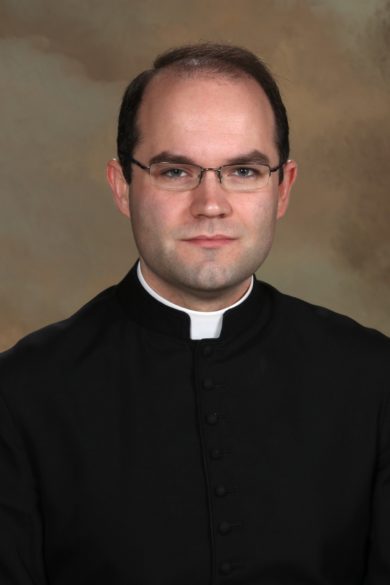SPIRIT AND TRUTH
By Father Aaron Williams
This past month, the priests, deacons and lay ecclesial ministers of our Diocese met for a workshop on the ars celebrandi, or the “art of celebrating” the sacred liturgy. During discussions with some of the attendants, I thought about certain small practices in the church’s liturgy which in most places have fallen away, but still exist as legitimate parts of the rite and, in some cases are technically still required, even though they are not done in most places.
The Venerable Archbishop Fulton Sheen, in providing commentary to a televised Mass, once remarked that the church’s liturgical vision never totally sacrifices practices that once held a place of honor. So, in that spirit, I thought I would share three of these practices, their history, and why they remain part of our tradition still today.
I remember when I was growing up, I’d see old photos of Mass and notice this tent-looking apparatus sitting in the center of the altar. It was only when I made it to seminary that I learned that traditionally the chalice was veiled during the Mass, to be unveiled at the offertory. The General Instruction of the Roman Missal states, “It is a praiseworthy practice for the chalice to be covered with a veil, which may be either of the color of the day or white.” (118.c) ‘Praiseworthy,’ of course, does not mean required but it does mean that the church considers this practice a good thing and encourages parishes to consider doing it.

We in the church have a tradition of veiling important things. Tabernacles are traditionally veiled, the altar is veiled in cloth, the priest is veiled in vestments. The veiling of the chalice for the first half of the Mass reminds us that this chalice is sacred — consecrated both by a special blessing and by the frequent contact of the Most Precious Blood. Veiling a chalice subconsciously reminds us that this is no mere cup, and it helps us remember to treat sacred things in a reverent and careful manner.
When I unveil the chalice at the offertory, I like to remind myself of the veil of the temple being torn in two. Christ, in this sacrifice on Calvary, opened the way for all of us to participate in true worship; and now, in the Holy Mass, He is once again opening the way for us to participate in His sacrifice.
Regarding the cleaning of the vessels after communion, the General Instruction states, “The purification of the chalice is done with water alone or with wine and water, which is then drunk by whoever does the purification.” (279)
When I was first ordained, I did what most priests do and just purified the chalice with water. But, when I started celebrating for school Masses and was responsible of purifying several chalices, (if I may say so reverently), I was a little nervous about the fact that schools are usually filled with a hundred variants of the common cold, and all those viruses are now inside a single chalice which I am about to drink.
Then, I remembered I could purify the chalice with wine as well. Wine is a natural disinfectant, and it makes sense why the practice of purifying the chalice with wine arose in the middle ages particularly in response to disease. Especially in light of the COVID-19 pandemic, I have been making sure to purify both the chalice and the ciborium with wine.
To purify in this manner, the priest simply pours wine in the chalice first, then follows it with water. The proportion is up to the priest, but should probably be such that the purificator is not totally soiled.
Finally, and this may surprise people, the instruction Redemptionis Sacramentum, promulgated by Pope St. John Paul II in 2004 gives the following direction: “The communion-paten for the communion of the faithful should be retained, so as to avoid the danger of the sacred host or some fragment of it falling.” (93) Most people who remember the communion paten probably associate it with kneeling at the railing as a child before the liturgy was reformed, but technically speaking, this practice is still required in the modern liturgy. These handy patens are usually equipped with a long handle so that the altar sever may hold it out beneath the hands or mouth of the communicant.
It is the devout teaching of the church that every single particle of the Sacred Host is the total Body, Blood, Soul and Divinity of Jesus Christ. And, for that reason the church is very careful to protect these small particles from any danger of being lost, stepped on, or sucked up into a vacuum cleaner. I started using communion patens at Mass a few months ago and was surprised that even when holding the paten beneath hands during Communion, I nearly always found particles collected on the paten after communion.
One added benefit of the communion paten is that is gives the servers something else to do. Most servers are bored at Mass today because we don’t let them do all things that servers should be doing such as carrying candles and trying not to burn the sacristy down while lighting the incense. Kids who serve as Mass like to be useful, and this is a very reverent way for them to assist during Communion while also teaching them about the holiness of the Sacred Host.
(Father Aaron Williams is parochial vicar at St. Patrick and St. Joseph Meridian.)
